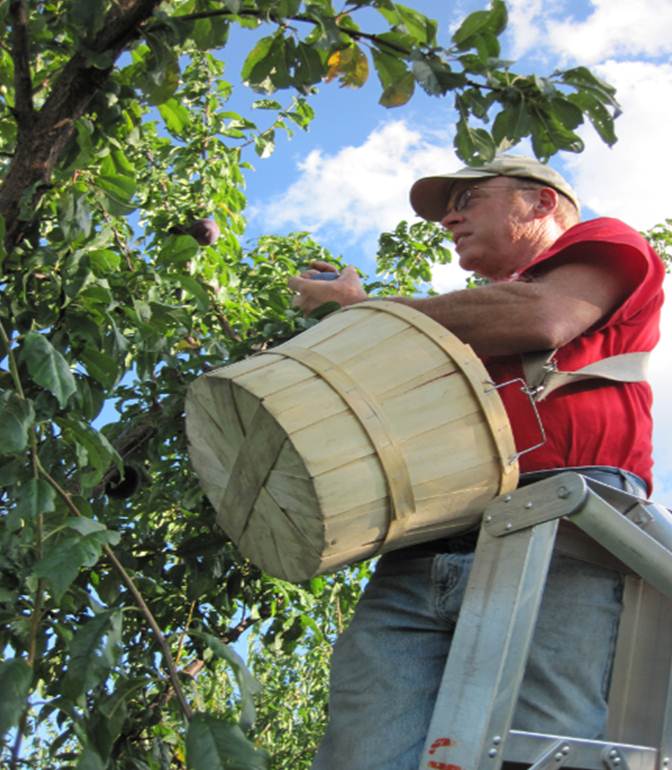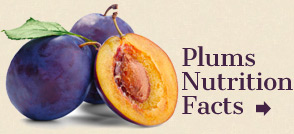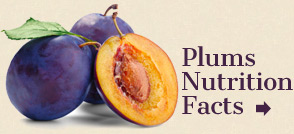Harvesting and Handling
 Plums, when mature, will generally come off the branch with a slight twist, leaving the stem (petiole) on the fruit. As plums ripen, the green coloration disappears from the background ground color, accompanied by softer flesh, and aromatic smell. Each plum has a characteristic color. Purple varieties as they ripen change from green to greenish-blue, then to dark blue or purple.
Plums, when mature, will generally come off the branch with a slight twist, leaving the stem (petiole) on the fruit. As plums ripen, the green coloration disappears from the background ground color, accompanied by softer flesh, and aromatic smell. Each plum has a characteristic color. Purple varieties as they ripen change from green to greenish-blue, then to dark blue or purple.
Fruit will have the best flavor if allowed to ripen on the tree and eaten right away. Plums store longer if picked when mature but before it is soft and prone to bruising.
Commercial growers can monitor fruit ripening with a mechanical penetrometer with an 8 mm-diameter tip to measure flesh firmness with the peel off. Measurement of fruit firmness is useful to determine ripeness for plum varieties that have the skin ground color masked by a full blush.
Most plum varieties require 2 to 3 harvests to obtain fruit of the desired maturity because plums generally ripen unevenly on the tree.
Shipping mature. Plums with more than 5 to 7 pounds flesh firmness can be shipped to regional markets. Fruit at this firmness will generally not “give” when pressed gently with a thumb.
Well-mature. Plums with approximately 5 pounds flesh firmness are ready for the retail market, in preparation for putting on display
Ready to eat. Plums with 2-3 pounds -force flesh firmness are considered "ready to eat". These are suitably mature for sale and eating within 1 to 2 days. Plums at this level of mature will “give” slightly when pressed gently with the side of a thumb, but generally will not retain a mark.
Ripening of hard plums can be accelerated by placing several in a loosely closed paper bag and leaving them at room temperature for a day or two.
The optimum temperature for storing plum is 30 to 32°F, with relative humidity of 90-95%.
Chilling Injury. Some plum varieties have a tendency to develop dry-flesh mealiness when very firm fruit are stored in the temperature range of 36 to 46 F. The speed of mealiness development depends on the variety. Shelf life is longer and generally less mealiness occurs when properly ripened fruit is stored at 32 F.
Brown rot caused by the fungus Monilia fructicola is the most important pre- and postharvest disease of plums. Infection can begin during bloom and fruit rot may occur before harvest and s postharvest. Control of insect pests and birds will help to reduce fruit injuries that encourage brown rot development. Orchard sanitation such as removal of mummified fruit help to minimize brown rot infection sources. Preharvest fungicide application and prompt cooling after harvest are among the control strategies. Also, postharvest fungicide treatment may be used.
Gray Mold, caused by the fungus Botrytis cinerea, is generally a minor problem of plums in Michigan. This disease is favored by wet spring weather and fruit injuries. Gray mold problems can intensify in storage if infected fruit are allowed to contaminate other fruit. Avoiding mechanical injury to fruit during harvest, and good temperature management in storage are effective control measures.
Rhizopus Rot is caused by the fungus Rhizopus stolonifer and can occur in ripening fruit stored at temperatures above 65 F. Avoiding overripe fruit, storing ripe fruit below 40 F helps to avoid this disease.




